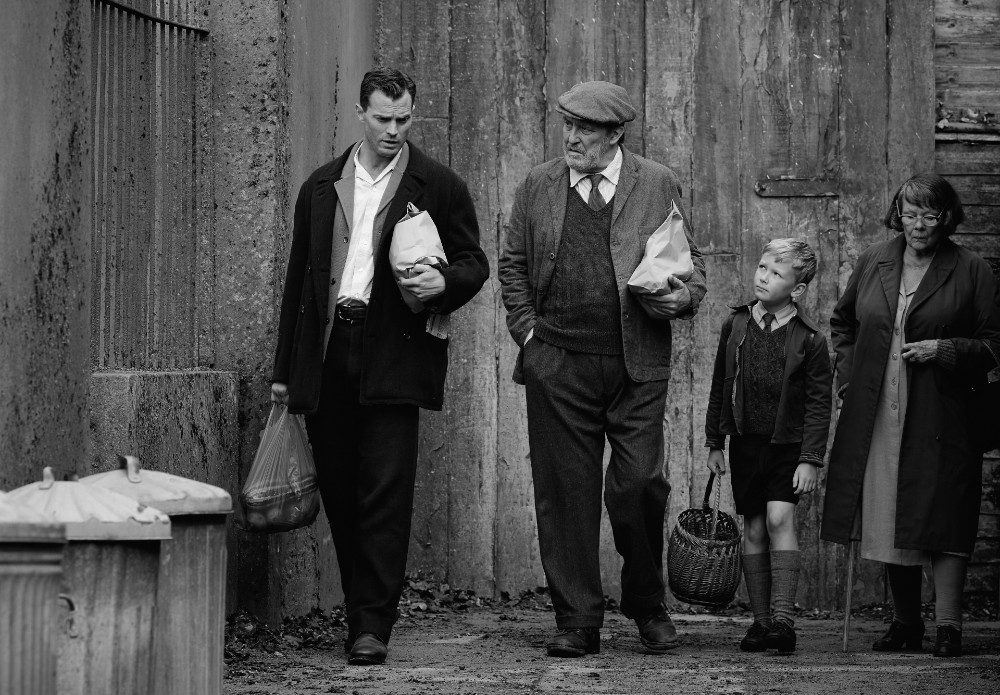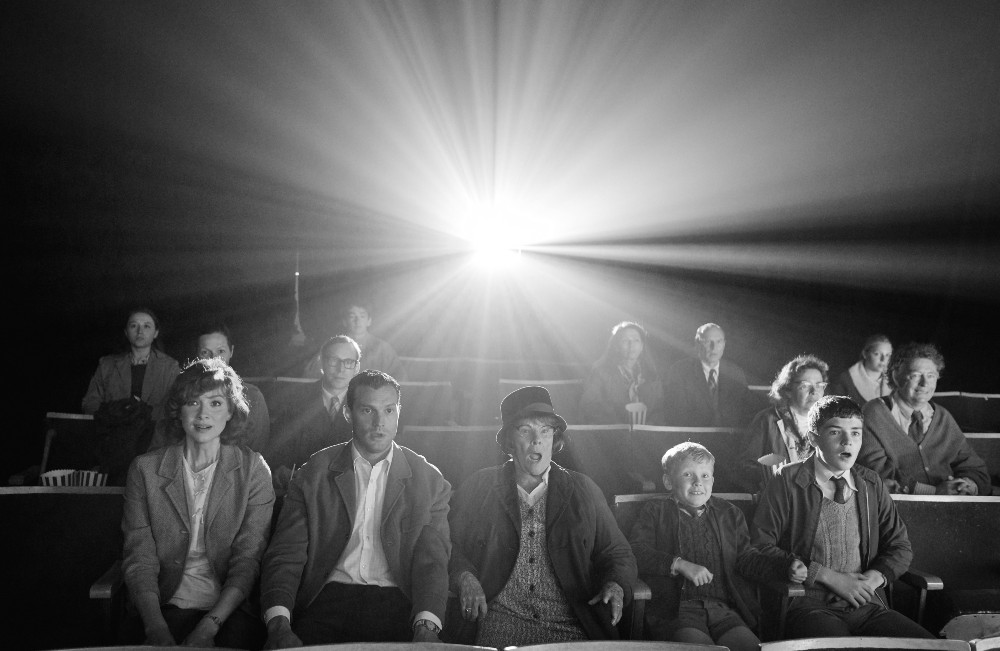
Two-time BAFTA-winning Production Designer Jim Clay teamed up for the fourth time in his career with Kenneth Branagh on the filmmaker’s passion project, Belfast. He previously had been nominated by the Art Directors Guild for his work on Branagh’s Murder on the Orient Express, as well as another nomination for Alfonso Cuaron’s Children of Men.
Belfast is one of a number of black and white films being released in the fall of 2021, and it’s a very personal story for Branagh that could only have been made as a result of the pandemic. The film is a semi-autobiographical take of Branagh’s life at the start of The Troubles in the late 1960s. Starring Caitríona Balfe, Judi Dench, Jamie Dornan, Ciarán Hinds, and introduces Jude Hill, it depicts a story of love, laughs, and loss in childhood set against a backdrop of music and social tumult.
The Belfast production took over an airport, where they recreated the street that filmmaker Kenneth Branagh grew up on. Because of the Covid protocols, taking over the actual street was not an option. Clay discusses the challenges that came with designing the film because of the pandemic, and also discusses his research process. He has a familiarity with the city because of having worked in Belfast many years ago for one of Mike Leigh’s earlier films. That was about 15 years after the time in which the film takes place.

Below the Line: How did you first get an interest in production design?
Jim Clay: I think from a very, very, very early age, I was taken to the cinema by my mom and dad. I saw a school production when I was probably 10 or 12 of a Gilbert and Sullivan opera. I embarked on making a model theater, and I took a great interest in architecture, and I trained to be an architect originally before entering television and then film. I think it’s been in me from a very, very early age.
BTL: Belfast marks your fourth collaboration with Kenneth Branagh. How has the shorthand improved?
Jim Clay: I think enormously, and especially with a production like Belfast, where we really had quite a very short time to prep it because of the COVID situation. The shorthand that existed already between Ken, Haris Zambarloukos, the director of photography, and myself, really paid dividends during the prep of Belfast.
BTL: What was the most challenging aspect of designing Belfast?
Clay: I have to say the COVID scenario, because we began production, I guess it was June 2020. This country and the film business was just emerging, tentatively, from the first lockdown and there was a lot of talk of another lockdown in the autumn. We knew we just had a very short window of opportunity to make this. Normally, a movie of this kind of scale, we would be going onto locations, but in our newly socially-distanced world, that wasn’t really an option. We set about building the street and its composite interiors. It was a timeframe of getting that built so that it was believable, plausible. It was a real world. I guess that was the biggest challenge.
BTL: When I saw the film for the first time back in October, I could not believe that that was the end of an airport runway.
Clay: (Laughs) It’s an odd choice, isn’t it—to build it at the end of the runway of all places? But the truth of the matter was most of the studios were in lockdown. They had standing sets. There was very little studio space, if any, available at that time. We opted to take an empty old school building in Surrey, England, which was our production headquarters, and that was probably 10 miles from Farnborough Airport. It was part of the airport, but it was also a big exhibition space. They were suffering, again, with the lockdown. Their exhibition halls were empty. Their car parks were empty. We were able to build there.
BTL: When you’re building a set of this nature, do you ever factor in potential camera placement, or do things just happen as they happen?
Clay: No, no, very much, we factor in the camera placement. That’s the collaboration I’ve had over the years with Haris and, obviously, with Ken. That’s very much planned. We were sort of forced into building the street and its interiors because of Covid. But I have to say, that’s Ken’s preferred method of making the other movies we’ve done, which is on a much bigger scale. We pretty much build a lot of the scenery, a lot of the sets, because it gives complete control over the schedule of lighting, just the control of the world in which we’re working. It is their preferred method—it’s just that on Belfast, we didn’t think we would be of the scale that we could do that. Ken, being a brilliant producer as well as director, he managed to make those resources available and we were able to do it.
BTL: What were some of the things that struck you upon your initial visit to Belfast for research?
Clay: I was fortunate that I’d worked there some years ago, actually, on an early Mike Leigh film called Four Days in July. This was, I guess, about 15 years after the period we were set in, but The Troubles were still existing. The streets obviously were as they were in the late 60s. I had that knowledge and experience of the real place. It was really reference from Ken and that reference took the form mostly of conversations we had the weekend when we went to Belfast really just to scout, thinking we would not film there, but we were able to walk the streets, although Ken’s actual house doesn’t actually exist anymore. Obviously, the street does, and the geography does, so we were able to take that journey that he took as a nine-year-old boy from home to school and through the park railings and across the field and to the school and then the reverse journey. That was a fabulous two days just walking the streets and listening to him talk about his memories. It was rewarding and it was quite emotional at the time as well.
BTL: Outside of touring the area, what kind of research did you do?
Clay: Obviously, it’s well documented—the terms of The Troubles – so a lot of photo archive, photo research, a lot exists. We were fortunate in that.

BTL: With the film being shot in black and white, what kind of impact does it have on the production design?
Clay: We love shooting in black and white. In fact, all the movies we do with Ken and Haris, we try to do a little black and white sequence somehow somewhere. When Ken said we’re going to shoot the whole thing in black and white, it was, “Well, this is great!” The impact I think is mostly to do with tonal values, I guess. We build the set in color as would be normal. But I was taking account of if I was going to paint a door or a wall, this particular color, and then maybe the window frame or the door frame, I was just making sure that those tonal values between the two colors would work strongly in black and white. That was a conversation with Haris, and we did a little bit of test shooting with our palette of colors. It had a big impact. I think it’s a powerful emotional statement, black and white. It helps to take you into the period, also.
BTL: Do you approach period films any differently than you do a contemporary or fantasy film?
Clay: I don’t think so. You’re building a world. I think my job as a production designer is to create a psychological climate for the director and his story and the actors. Whether it’s period or contemporary, you embark on the job in the same way designing paces and volumes with camera shots in mind, action in mind and obviously, lighting in mind, placement of windows within the volumes. I think that the design process is very similar regardless of period.
BTL: In terms of the design process, has it changed over the years with all the changes in the industry?
Clay: Yes, it has, in some ways. I think going way back with the introduction of CGI, blue screen, green screen. To begin with, I think a lot of people found that as a little bit of a threat to production design. In fact, it’s the reverse. It’s extended our world, so that we could design bigger and better things and it would be realized virtually. Camera techniques, lighting techniques, obviously, visual effects techniques have all improved phenomenally. All these advancements you’d make use of. And of course, the latest one is this thing called The Volume, which is the big LED screens. Some of the set can be built digitally there. It’s an in-camera thing; it’s not something which is done in post. I think we’re learning how to use that at the moment in the best way. We’ve done some bits on the movie I’m working on at the moment. That’s the latest of those technologies.
BTL: How honored are you that your name is out there in the awards conversation for production design?
Clay: Hugely honored. I mean, Belfast is a fantastic movie. It’s a wonderful, heartfelt movie that it’s wonderful to be attached to. The fact that it’s garnering such accolades for Ken and the actors is phenomenal. To be on the journey with that is terrific.
Belfast is now playing in theaters and is also available On Demand.
All photos courtesy and copyright Focus Features; Photographer: Rob Youngson.





